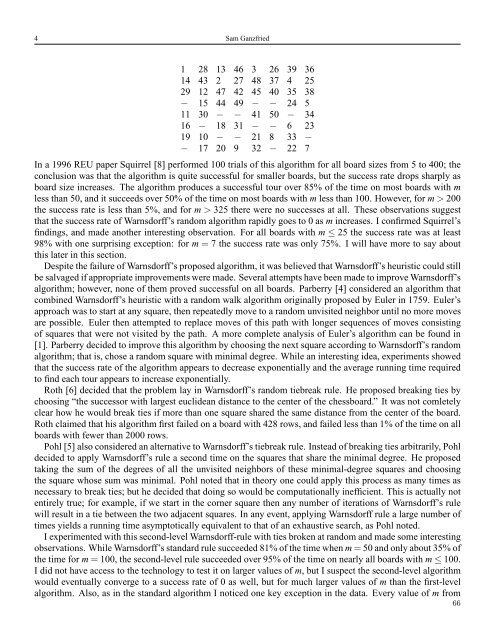A SIMPLE ALGORITHM FOR KNIGHT'S TOURS Chess is a two ...
A SIMPLE ALGORITHM FOR KNIGHT'S TOURS Chess is a two ...
A SIMPLE ALGORITHM FOR KNIGHT'S TOURS Chess is a two ...
You also want an ePaper? Increase the reach of your titles
YUMPU automatically turns print PDFs into web optimized ePapers that Google loves.
4 Sam Ganzfried1 28 13 46 3 26 39 3614 43 2 27 48 37 4 2529 12 47 42 45 40 35 38− 15 44 49 − − 24 511 30 − − 41 50 − 3416 − 18 31 − − 6 2319 10 − − 21 8 33 −− 17 20 9 32 − 22 7In a 1996 REU paper Squirrel [8] performed 100 trials of th<strong>is</strong> algorithm for all board sizes from 5 to 400; theconclusion was that the algorithm <strong>is</strong> quite successful for smaller boards, but the success rate drops sharply asboard size increases. The algorithm produces a successful tour over 85% of the time on most boards with mless than 50, and it succeeds over 50% of the time on most boards with m less than 100. However, for m > 200the success rate <strong>is</strong> less than 5%, and for m > 325 there were no successes at all. These observations suggestthat the success rate of Warnsdorff’s random algorithm rapidly goes to 0 as m increases. I confirmed Squirrel’sfindings, and made another interesting observation. For all boards with m ≤ 25 the success rate was at least98% with one surpr<strong>is</strong>ing exception: for m = 7 the success rate was only 75%. I will have more to say aboutth<strong>is</strong> later in th<strong>is</strong> section.Despite the failure of Warnsdorff’s proposed algorithm, it was believed that Warnsdorff’s heur<strong>is</strong>tic could stillbe salvaged if appropriate improvements were made. Several attempts have been made to improve Warnsdorff’salgorithm; however, none of them proved successful on all boards. Parberry [4] considered an algorithm thatcombined Warnsdorff’s heur<strong>is</strong>tic with a random walk algorithm originally proposed by Euler in 1759. Euler’sapproach was to start at any square, then repeatedly move to a random unv<strong>is</strong>ited neighbor until no more movesare possible. Euler then attempted to replace moves of th<strong>is</strong> path with longer sequences of moves cons<strong>is</strong>tingof squares that were not v<strong>is</strong>ited by the path. A more complete analys<strong>is</strong> of Euler’s algorithm can be found in[1]. Parberry decided to improve th<strong>is</strong> algorithm by choosing the next square according to Warnsdorff’s randomalgorithm; that <strong>is</strong>, chose a random square with minimal degree. While an interesting idea, experiments showedthat the success rate of the algorithm appears to decrease exponentially and the average running time requiredto find each tour appears to increase exponentially.Roth [6] decided that the problem lay in Warnsdorff’s random tiebreak rule. He proposed breaking ties bychoosing “the successor with largest euclidean d<strong>is</strong>tance to the center of the chessboard.” It was not comletelyclear how he would break ties if more than one square shared the same d<strong>is</strong>tance from the center of the board.Roth claimed that h<strong>is</strong> algorithm first failed on a board with 428 rows, and failed less than 1% of the time on allboards with fewer than 2000 rows.Pohl [5] also considered an alternative to Warnsdorff’s tiebreak rule. Instead of breaking ties arbitrarily, Pohldecided to apply Warnsdorff’s rule a second time on the squares that share the minimal degree. He proposedtaking the sum of the degrees of all the unv<strong>is</strong>ited neighbors of these minimal-degree squares and choosingthe square whose sum was minimal. Pohl noted that in theory one could apply th<strong>is</strong> process as many times asnecessary to break ties; but he decided that doing so would be computationally inefficient. Th<strong>is</strong> <strong>is</strong> actually notentirely true; for example, if we start in the corner square then any number of iterations of Warnsdorff’s rulewill result in a tie between the <strong>two</strong> adjacent squares. In any event, applying Warnsdorff rule a large number oftimes yields a running time asymptotically equivalent to that of an exhaustive search, as Pohl noted.I experimented with th<strong>is</strong> second-level Warnsdorff-rule with ties broken at random and made some interestingobservations. While Warnsdorff’s standard rule succeeded 81% of the time when m = 50 and only about 35% ofthe time for m = 100, the second-level rule succeeded over 95% of the time on nearly all boards with m ≤ 100.I did not have access to the technology to test it on larger values of m, but I suspect the second-level algorithmwould eventually converge to a success rate of 0 as well, but for much larger values of m than the first-levelalgorithm. Also, as in the standard algorithm I noticed one key exception in the data. Every value of m from66
















